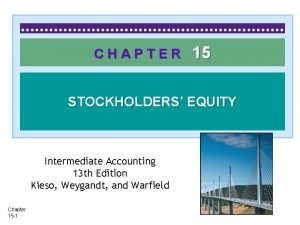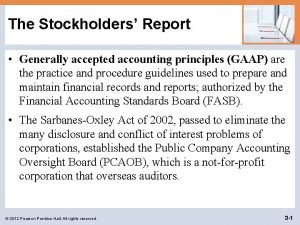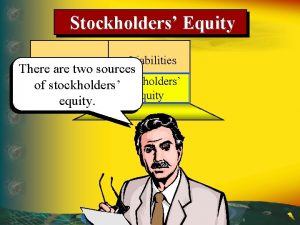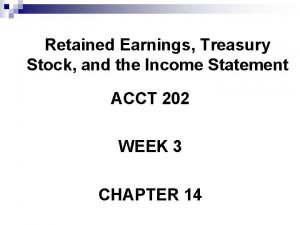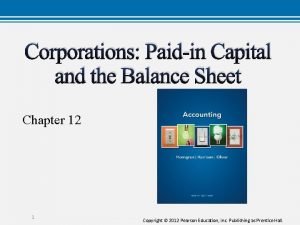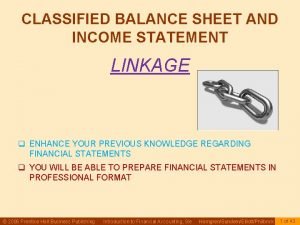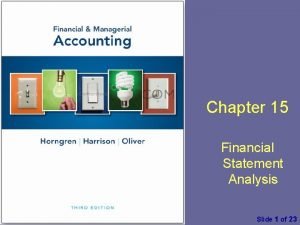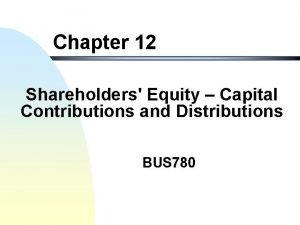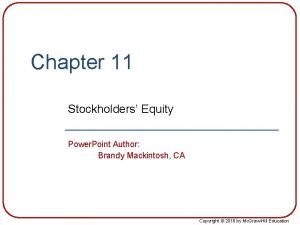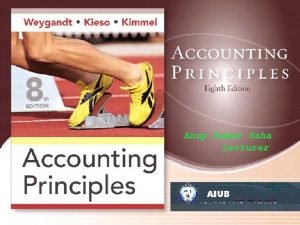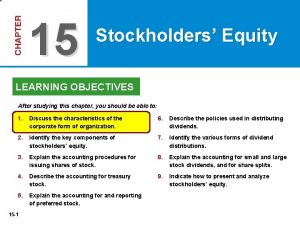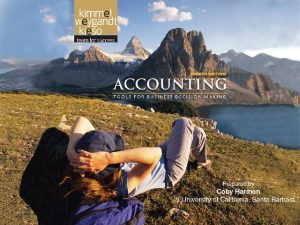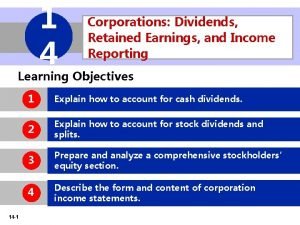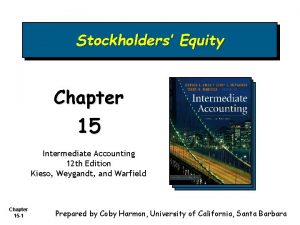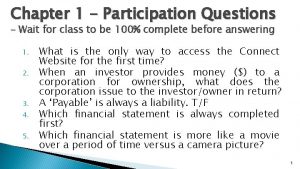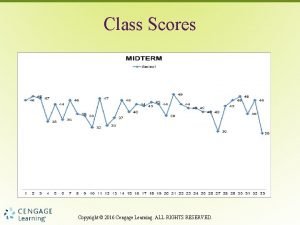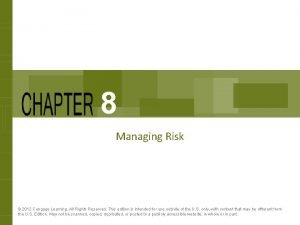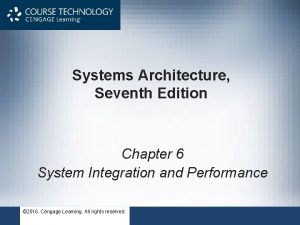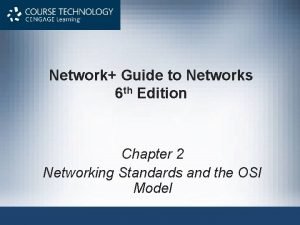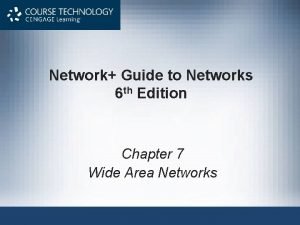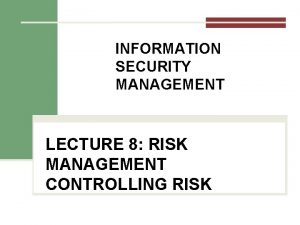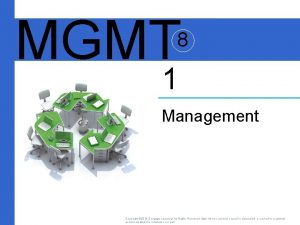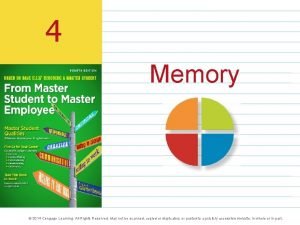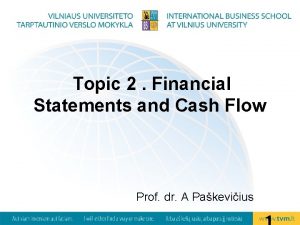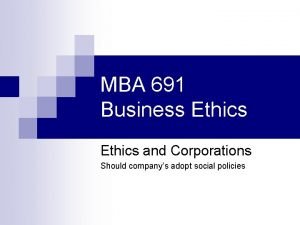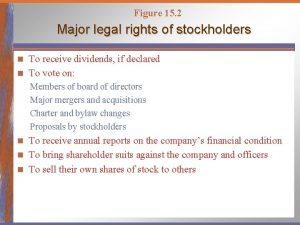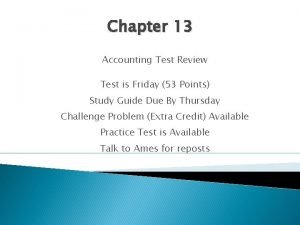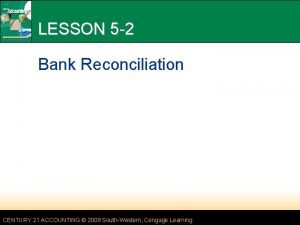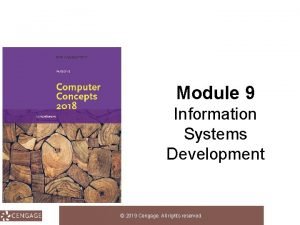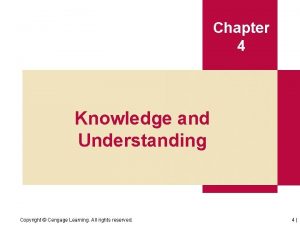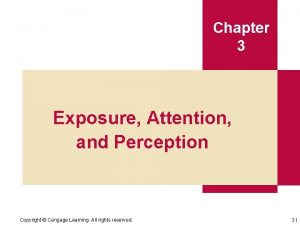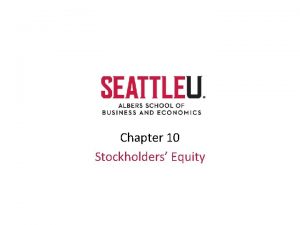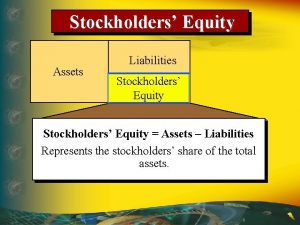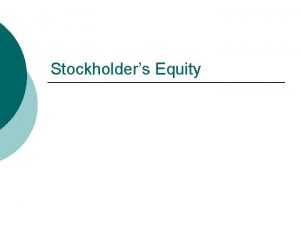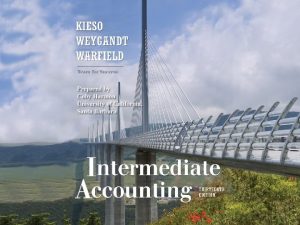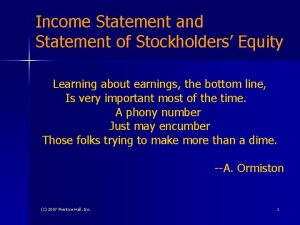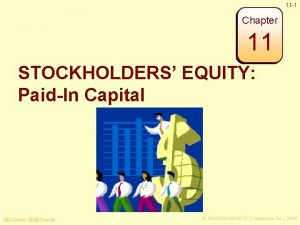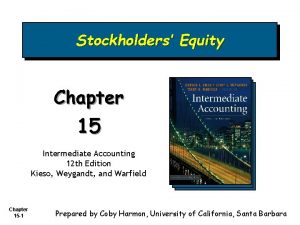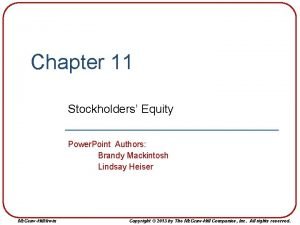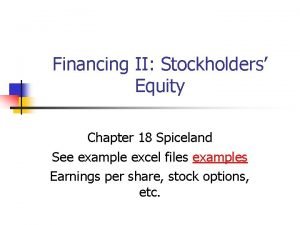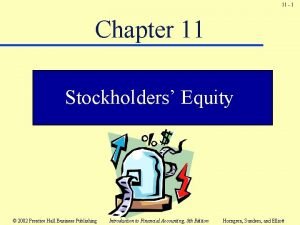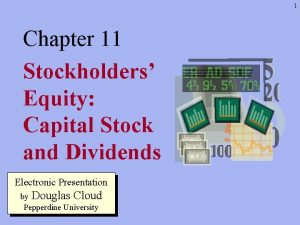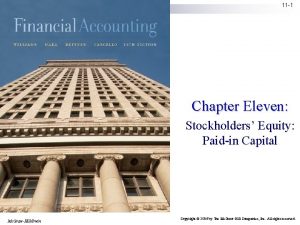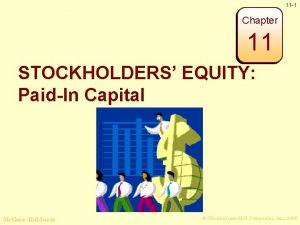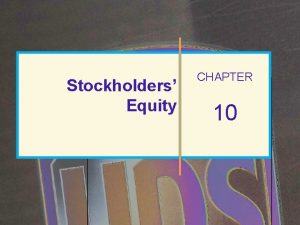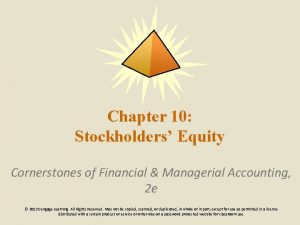Chapter 11 Stockholders Equity 2017 Cengage Learning May
















































































- Slides: 80

Chapter 11 Stockholders’ Equity © 2017 Cengage Learning®. May not be scanned, copied or duplicated, or posted to a publicly accessible website, in whole or in part, except for use as permitted in a license distributed with a certain product or service or otherwise on a password-protected website or school-approved learning management system for classroom use.

Learning Objectives LO 1 LO 2 LO 3 LO 4 LO 5 Understand the concept of stockholders’ equity and identify the components of the Stockholders’ Equity category. Show that you understand the characteristics of common and preferred stock and the differences between the classes of stock. Determine the financial statement impact when stock is issued for cash or for other consideration. Describe the financial statement impact of stock treated as treasury stock. Compute the amount of cash dividends when a firm has issued both preferred and common stock. © 2017 Cengage Learning®. May not be scanned, copied or duplicated, or posted to a publicly accessible website, in whole or in part, except for use as permitted in a license distributed with a certain product or service or otherwise on a password-protected website or school-approved learning management system for classroom use.

Learning Objectives (continued) LO 6 Show that you understand the difference between cash and stock dividends and the effect of stock dividends. LO 7 Determine the difference between stock dividends and stock splits. LO 8 Show that you understand the statement of stockholders’ equity and comprehensive income. LO 9 Understand how investors use ratios to evaluate stockholders’ equity. LO 10 Explain the effects that transactions involving stockholders’ equity have on the statement of cash flows. © 2017 Cengage Learning®. May not be scanned, copied or duplicated, or posted to a publicly accessible website, in whole or in part, except for use as permitted in a license distributed with a certain product or service or otherwise on a password-protected website or school-approved learning management system for classroom use.

Learning Objectives (continued) LO 11 Describe the important differences between the sole proprietorship and partnership forms of organization versus the corporate form (Appendix). © 2017 Cengage Learning®. May not be scanned, copied or duplicated, or posted to a publicly accessible website, in whole or in part, except for use as permitted in a license distributed with a certain product or service or otherwise on a password-protected website or school-approved learning management system for classroom use.

Module 1 Stockholders’ Equity, Issuance of Stock, and Treasury Stock q There are various components presented in the Stockholders’ Equity section of the balance sheet q There are different types of stock that companies can issue and there advantages of each class of stock q Treasury stock is important Module 1 © 2017 Cengage Learning®. May not be scanned, copied or duplicated, or posted to a publicly accessible website, in whole or in part, except for use as permitted in a license distributed with a certain product or service or otherwise on a password-protected website or school-approved learning management system for classroom use.

Stockholders’ Equity q Owners of a corporation and have a residual interest in assets after liabilities are satisfied Module 1: LO 1 © 2017 Cengage Learning®. May not be scanned, copied or duplicated, or posted to a publicly accessible website, in whole or in part, except for use as permitted in a license distributed with a certain product or service or otherwise on a password-protected website or school-approved learning management system for classroom use.

Exhibit 11 -1—Advantages and Disadvantages of Stock versus Debt Financing Module 1: LO 1 © 2017 Cengage Learning®. May not be scanned, copied or duplicated, or posted to a publicly accessible website, in whole or in part, except for use as permitted in a license distributed with a certain product or service or otherwise on a password-protected website or school-approved learning management system for classroom use.

Stockholders’ Equity on the Balance Sheet q The basic accounting equation: Assets = Liabilities + Stockholders’ Equity q Two major components or subcategories: Ø Contributed Capital Ø Retained Earnings Total Stockholders’ Equity = Contributed Capital + Retained Earnings Module 1: LO 1 © 2017 Cengage Learning®. May not be scanned, copied or duplicated, or posted to a publicly accessible website, in whole or in part, except for use as permitted in a license distributed with a certain product or service or otherwise on a password-protected website or school-approved learning management system for classroom use.

Components of the Stockholders’ Equity Section of the Balance Sheet q Number of Shares q Par Value q Additional Paid-In Capital q Retained Earnings Module 1: LO 1 © 2017 Cengage Learning®. May not be scanned, copied or duplicated, or posted to a publicly accessible website, in whole or in part, except for use as permitted in a license distributed with a certain product or service or otherwise on a password-protected website or school-approved learning management system for classroom use.

Exhibit 11 -2—Retained Earnings Connects the Income Statement and the Balance Sheet Module 1: LO 1 © 2017 Cengage Learning®. May not be scanned, copied or duplicated, or posted to a publicly accessible website, in whole or in part, except for use as permitted in a license distributed with a certain product or service or otherwise on a password-protected website or school-approved learning management system for classroom use.

Contributed Capital q Common stock Ø Carries voting rights Ø The common stockholders elect the corporation’s officers • Establish its bylaws and governing rules q Preferred stock Ø Flexible and tailored to a company’s needs Ø Preference in dividends Module 1: LO 1 © 2017 Cengage Learning®. May not be scanned, copied or duplicated, or posted to a publicly accessible website, in whole or in part, except for use as permitted in a license distributed with a certain product or service or otherwise on a password-protected website or school-approved learning management system for classroom use.

Number of Shares q Authorized shares: the maximum number of shares a corporation may issue as indicated in the corporate charter q Issued shares: the number of shares sold or distributed to stockholders q Outstanding shares: the number of shares issued less the number of shares held as treasury stock Module 1: LO 1 © 2017 Cengage Learning®. May not be scanned, copied or duplicated, or posted to a publicly accessible website, in whole or in part, except for use as permitted in a license distributed with a certain product or service or otherwise on a password-protected website or school-approved learning management system for classroom use.

Par Value q An arbitrary amount that represents the legal capital of the firm q Stated on the face of the stock certificate q Also called “stated value” q Amount presented in the stock account Module 1: LO 1 © 2017 Cengage Learning®. May not be scanned, copied or duplicated, or posted to a publicly accessible website, in whole or in part, except for use as permitted in a license distributed with a certain product or service or otherwise on a password-protected website or school-approved learning management system for classroom use.

Additional Paid-In Capital and Retained Earnings q Additional paid-in capital: the amount received for the issuance of stock in excess of the par value of the stock q Retained earnings: net income that has been made by the corporation but not paid out as dividends Ø Not necessarily available to stockholders Ø May be used for purchase of assets, the retirement of debt, or other financial needs Module 1: LO 1 © 2017 Cengage Learning®. May not be scanned, copied or duplicated, or posted to a publicly accessible website, in whole or in part, except for use as permitted in a license distributed with a certain product or service or otherwise on a password-protected website or school-approved learning management system for classroom use.

IFRS and Stockholders’ Equity Convertible bond q International accounting rules Ø Separated into equity q U. S. accounting two parts—liability and stockholders’ standards Ø Do not require to be recorded as a separate amount Ø Recorded as either liability or stockholders’ equity Module 1: LO 1 © 2017 Cengage Learning®. May not be scanned, copied or duplicated, or posted to a publicly accessible website, in whole or in part, except for use as permitted in a license distributed with a certain product or service or otherwise on a password-protected website or school-approved learning management system for classroom use.

Preferred Stock q Flexible and tailored to a company’s needs q Preference to dividends before the common stockholders q Right to the company’s assets before the common stockholders during liquidation q The dividend rate maybe stated in two ways: Ø Percentage of the stock’s par value Ø Per-share amount Module 1: LO 2 © 2017 Cengage Learning®. May not be scanned, copied or duplicated, or posted to a publicly accessible website, in whole or in part, except for use as permitted in a license distributed with a certain product or service or otherwise on a password-protected website or school-approved learning management system for classroom use.

Preferred Stock Additional Terms and Features q Convertible: allows preferred stock to be exchanged for common stock q Redeemable: allows stockholders to sell stock back to the company q Callable: Allows the firm to eliminate a class of stock by paying the stockholders a specified amount Module 1: LO 2 © 2017 Cengage Learning®. May not be scanned, copied or duplicated, or posted to a publicly accessible website, in whole or in part, except for use as permitted in a license distributed with a certain product or service or otherwise on a password-protected website or school-approved learning management system for classroom use.

Preferred Stock Additional Terms and Features (continued) q Cumulative: the right to dividends in arrears before the current-year dividend is distributed q Participating: Allows preferred stockholders to share on a percentage basis in the distribution of an abnormally large dividend Module 1: LO 2 © 2017 Cengage Learning®. May not be scanned, copied or duplicated, or posted to a publicly accessible website, in whole or in part, except for use as permitted in a license distributed with a certain product or service or otherwise on a password-protected website or school-approved learning management system for classroom use.

Issuance of Stock q Issued for cash or for noncash assets q When issued for cash: Ø Par value reported in the stock account Ø Amount in excess of par is reported in the Paid-In Capital account q When exchanged for noncash items: Ø Recorded at the fair market value of the stock or the assets received, whichever is most readily determined Module 1: LO 3 © 2017 Cengage Learning®. May not be scanned, copied or duplicated, or posted to a publicly accessible website, in whole or in part, except for use as permitted in a license distributed with a certain product or service or otherwise on a password-protected website or school-approved learning management system for classroom use.

Example 11 -1—Recording Stock Issued for Cash q q Assume that on July 1, a firm issued 1, 000 shares of $10 par common stock for $15 per share The transaction is recorded as follows: Module 1: LO 3 © 2017 Cengage Learning®. May not be scanned, copied or duplicated, or posted to a publicly accessible website, in whole or in part, except for use as permitted in a license distributed with a certain product or service or otherwise on a password-protected website or school-approved learning management system for classroom use.

Example 11 -2—Recording Stock for Noncash Consideration q q q Assume that on July 1, a firm issued 500 shares of $10 par preferred stock to acquire a building The building has recently been appraised by an independent firm as having a market value of $12, 000 The issuance of the stock should be recorded as follows: Module 1: LO 3 © 2017 Cengage Learning®. May not be scanned, copied or duplicated, or posted to a publicly accessible website, in whole or in part, except for use as permitted in a license distributed with a certain product or service or otherwise on a password-protected website or school-approved learning management system for classroom use.

Treasury Stock q Issued by the firm and then repurchased but not retired q Repurchase is recorded as a debit to Treasury Stock, a contra-equity account q For an amount to be treated as treasury stock: It must be the corporation’s own stock Ø It must have been issued to the stockholders at some point Ø It must have been repurchased from the stockholders Ø It must not be retired, but must be held for some purpose Ø Module 1: LO 4 © 2017 Cengage Learning®. May not be scanned, copied or duplicated, or posted to a publicly accessible website, in whole or in part, except for use as permitted in a license distributed with a certain product or service or otherwise on a password-protected website or school-approved learning management system for classroom use.

Example 11 -3—Recording the Purchase of Treasury Stock q The Stockholders’ Equity section of Rezin Company’s balance sheet on December 31, 2016, appears as follows: Module 1: LO 4 © 2017 Cengage Learning®. May not be scanned, copied or duplicated, or posted to a publicly accessible website, in whole or in part, except for use as permitted in a license distributed with a certain product or service or otherwise on a password-protected website or school-approved learning management system for classroom use.

Example 11 -3—Recording the Purchase of Treasury Stock (continued) q q Assume that on February 1, 2017, Rezin buys 100 of its shares as treasury stock at $25 per share Rezin records the following transaction at that time: Module 1: LO 4 © 2017 Cengage Learning®. May not be scanned, copied or duplicated, or posted to a publicly accessible website, in whole or in part, except for use as permitted in a license distributed with a certain product or service or otherwise on a password-protected website or school-approved learning management system for classroom use.

Example 11 -3—Recording the Purchase of Treasury Stock (continued) q The Stockholders’ Equity section of Rezin’s balance sheet on February 1, 2017, after the purchase of the treasury stock Module 1: LO 4 © 2017 Cengage Learning®. May not be scanned, copied or duplicated, or posted to a publicly accessible website, in whole or in part, except for use as permitted in a license distributed with a certain product or service or otherwise on a password-protected website or school-approved learning management system for classroom use.

Retirement of Stock q Repurchase of stock with no intention of reissuing q To eliminate a particular class of stock or group of stockholders q The general principle for retirement of stock is the same as for treasury stock transactions q No income statement accounts are affected q Effect is reflected in the Cash account and the Stockholders’ Equity accounts Module 1: LO 4 © 2017 Cengage Learning®. May not be scanned, copied or duplicated, or posted to a publicly accessible website, in whole or in part, except for use as permitted in a license distributed with a certain product or service or otherwise on a password-protected website or school-approved learning management system for classroom use.

Module 2 Cash Dividends, Stock Dividends, and Stock Splits q A company might pay cash or stock dividends Module 2 © 2017 Cengage Learning®. May not be scanned, copied or duplicated, or posted to a publicly accessible website, in whole or in part, except for use as permitted in a license distributed with a certain product or service or otherwise on a password-protected website or school-approved learning management system for classroom use.

Cash Dividends q Declared only if a company has sufficient cash available and adequate retained earnings q Not an expense on the income statement q Date of declaration: cash dividends are declared q Payment date: cash dividends are paid q Date of record: dividend is paid to the stockholders who own the stock as of this date Module 2: LO 5 © 2017 Cengage Learning®. May not be scanned, copied or duplicated, or posted to a publicly accessible website, in whole or in part, except for use as permitted in a license distributed with a certain product or service or otherwise on a password-protected website or school-approved learning management system for classroom use.

Dividend Payout Ratio q The annual dividend amount divided by the annual net income q Ratio for many firms is 50% or 60% and seldom exceeds 70% Module 2: LO 5 © 2017 Cengage Learning®. May not be scanned, copied or duplicated, or posted to a publicly accessible website, in whole or in part, except for use as permitted in a license distributed with a certain product or service or otherwise on a password-protected website or school-approved learning management system for classroom use.

Example 11 -4—Recording the Declaration of a Dividend q q Assume that on July 1, the board of directors of Grant Company declared a cash dividend of $7, 000 to be paid on September 1 Grant reflects the declaration as a reduction of Retained Earnings and an increase in Cash Dividend Payable as follows: Module 2: LO 5 © 2017 Cengage Learning®. May not be scanned, copied or duplicated, or posted to a publicly accessible website, in whole or in part, except for use as permitted in a license distributed with a certain product or service or otherwise on a password-protected website or school-approved learning management system for classroom use.

Stock Dividends q The issuance of additional shares of stock to existing stockholders q Firms use stock dividends for several reasons Ø Do not require the use of cash Ø Reduce the market price of the stock • The lower price may make the stock more attractive Ø Do not represent taxable income to recipients Module 2: LO 6 © 2017 Cengage Learning®. May not be scanned, copied or duplicated, or posted to a publicly accessible website, in whole or in part, except for use as permitted in a license distributed with a certain product or service or otherwise on a password-protected website or school-approved learning management system for classroom use.

Example 11 -7—Recording a Small Stock Dividend q Assume that Shah Company’s Stockholders’ Equity category of the balance sheet appears as follows as of January 1, 2016: Module 2: LO 6 © 2017 Cengage Learning®. May not be scanned, copied or duplicated, or posted to a publicly accessible website, in whole or in part, except for use as permitted in a license distributed with a certain product or service or otherwise on a password-protected website or school-approved learning management system for classroom use.

Example 11 -7—Recording a Small Stock Dividend (continued) q q Assume that on January 2, 2016, Shah declares a 10% stock dividend to common stockholders to be distributed on April 1, 2016 Assume that Shah’s common stock is selling at $40 per share on that date Therefore, the total market value of the stock dividend is $20, 000 (10% of 5, 000 shares outstanding, or 500 shares, times $40 per share) Shah records the transaction on the date of declaration as follows: Module 2: LO 6 © 2017 Cengage Learning®. May not be scanned, copied or duplicated, or posted to a publicly accessible website, in whole or in part, except for use as permitted in a license distributed with a certain product or service or otherwise on a password-protected website or school-approved learning management system for classroom use.

Example 11 -7—Recording a Small Stock Dividend (continued) q The Stockholders’ Equity section of Shah’s balance sheet on January 2, 2016, is as follows after the declaration of the dividend: Module 2: LO 6 © 2017 Cengage Learning®. May not be scanned, copied or duplicated, or posted to a publicly accessible website, in whole or in part, except for use as permitted in a license distributed with a certain product or service or otherwise on a password-protected website or school-approved learning management system for classroom use.

q q Example 11 -8—Recording the Declaration of a Large Stock Dividend Assume that instead of a 10% dividend, on January 2, 2016, Shah declares a 100% stock dividend to be distributed on April 1, 2016 The stock dividend results in 5, 000 additional shares being issued and certainly meets the definition of a large stock dividend. Shah records the following transaction on January 2, the date of declaration: Module 2: LO 6 © 2017 Cengage Learning®. May not be scanned, copied or duplicated, or posted to a publicly accessible website, in whole or in part, except for use as permitted in a license distributed with a certain product or service or otherwise on a password-protected website or school-approved learning management system for classroom use.

q Example 11 -8—Recording the Declaration of a Large Stock Dividend (continued) The accounting transaction to be recorded when the stock is actually distributed is as follows: Module 2: LO 6 © 2017 Cengage Learning®. May not be scanned, copied or duplicated, or posted to a publicly accessible website, in whole or in part, except for use as permitted in a license distributed with a certain product or service or otherwise on a password-protected website or school-approved learning management system for classroom use.

q Example 11 -8—Recording the Declaration of a Large Stock Dividend (continued) The Stockholders’ Equity category of Shah’s balance sheet as of April 1 after the stock dividend is as follows: Module 2: LO 6 © 2017 Cengage Learning®. May not be scanned, copied or duplicated, or posted to a publicly accessible website, in whole or in part, except for use as permitted in a license distributed with a certain product or service or otherwise on a password-protected website or school-approved learning management system for classroom use.

Stock Splits q The creation of additional shares of stock with a reduction of the par value of the stock q Stock dividends Ø Do not affect the par value per share of the stock Ø Recorded q Stock Splits Ø Reduce the par value per share Ø Not recorded Ø Stockholders’ Equity accounts are not affected Module 2: LO 7 © 2017 Cengage Learning®. May not be scanned, copied or duplicated, or posted to a publicly accessible website, in whole or in part, except for use as permitted in a license distributed with a certain product or service or otherwise on a password-protected website or school-approved learning management system for classroom use.

Example 11 -9—Reporting a Stock Split q q q Assume that on January 2, 2016, Shah issued a 2 -for-1 stock split instead of a stock dividend The split results in an additional 5, 000 shares of stock outstanding but is not recorded in a formal accounting transaction Therefore, the Stockholders’ Equity section of Shah Company immediately after the stock split on January 2, 2016, is as follows: Module 2: LO 7 © 2017 Cengage Learning®. May not be scanned, copied or duplicated, or posted to a publicly accessible website, in whole or in part, except for use as permitted in a license distributed with a certain product or service or otherwise on a password-protected website or school-approved learning management system for classroom use.

Module 3 Analysis and Cash Flow Issues q Comprehensive income differs from the net income amount a company may present q Stockholders’ equity items affect the cash flow statement Module 3 © 2017 Cengage Learning®. May not be scanned, copied or duplicated, or posted to a publicly accessible website, in whole or in part, except for use as permitted in a license distributed with a certain product or service or otherwise on a password-protected website or school-approved learning management system for classroom use.

Statement of Stockholders’ Equity q Reflects the reasons for the difference between the beginning and ending balances for all accounts in the Stockholders’ Equity category of the balance sheet Module 3: LO 8 © 2017 Cengage Learning®. May not be scanned, copied or duplicated, or posted to a publicly accessible website, in whole or in part, except for use as permitted in a license distributed with a certain product or service or otherwise on a password-protected website or school-approved learning management system for classroom use.

Exhibit 11 -3—Fun Fitness’s Statement of Stockholders’ Equity, 2016 Module 3: LO 8 © 2017 Cengage Learning®. May not be scanned, copied or duplicated, or posted to a publicly accessible website, in whole or in part, except for use as permitted in a license distributed with a certain product or service or otherwise on a password-protected website or school-approved learning management system for classroom use.

Exhibit 11 -3—Fun Fitness’s Statement of Stockholders’ Equity, 2016 (continued) Module 3: LO 8 © 2017 Cengage Learning®. May not be scanned, copied or duplicated, or posted to a publicly accessible website, in whole or in part, except for use as permitted in a license distributed with a certain product or service or otherwise on a password-protected website or school-approved learning management system for classroom use.

Comprehensive Income q Total change in net assets from all sources except investments by or distributions to the owners q Important measure of a company’s profitability q One-statement approach Ø Shown at the bottom of the income statement q Two-statement approach Ø Statement of Comprehensive Income must be presented Module 3: LO 8 © 2017 Cengage Learning®. May not be scanned, copied or duplicated, or posted to a publicly accessible website, in whole or in part, except for use as permitted in a license distributed with a certain product or service or otherwise on a password-protected website or school-approved learning management system for classroom use.

Exhibit 11 -4—The Relationship between the Income Statement and the Statement of Comprehensive Income Module 3: LO 8 © 2017 Cengage Learning®. May not be scanned, copied or duplicated, or posted to a publicly accessible website, in whole or in part, except for use as permitted in a license distributed with a certain product or service or otherwise on a password-protected website or school-approved learning management system for classroom use.

Book Value Per Share q Book value per share: total stockholders’ equity divided by the number of shares of common stock outstanding q If preferred stock is present, stockholders’ equity must be adjusted to reflect its liquidation value Module 3: LO 9 © 2017 Cengage Learning®. May not be scanned, copied or duplicated, or posted to a publicly accessible website, in whole or in part, except for use as permitted in a license distributed with a certain product or service or otherwise on a password-protected website or school-approved learning management system for classroom use.

Calculating Book Value When Preferred Stock Is Present q If preferred stock is present, stockholders’ equity must be adjusted to reflect its liquidation value Module 3: LO 9 © 2017 Cengage Learning®. May not be scanned, copied or duplicated, or posted to a publicly accessible website, in whole or in part, except for use as permitted in a license distributed with a certain product or service or otherwise on a password-protected website or school-approved learning management system for classroom use.

Exhibit 11 -5—Workout Wonders’ Stockholders’ Equity Section Module 3: LO 9 © 2017 Cengage Learning®. May not be scanned, copied or duplicated, or posted to a publicly accessible website, in whole or in part, except for use as permitted in a license distributed with a certain product or service or otherwise on a password-protected website or school-approved learning management system for classroom use.

q q Exhibit 11 -5—Workout Wonders’ Stockholders’ Equity Section (continued) The company had total stockholders’ equity in 2016 of $13, 972 million, but preferred stockholders had a right to $500 million in the event of liquidation Therefore, $500 million must be deducted to calculate the rights of the common stockholders: $13, 972 – $500 = $13, 472 million common stockholders’ equity The number of shares of common stock outstanding for the company is 1, 782 million issued less 103 million of treasury stock Therefore, the computation of book value per share is as follows: $13, 472/1, 679 = $8. 02 Book Value per Share Module 3: LO 9 © 2017 Cengage Learning®. May not be scanned, copied or duplicated, or posted to a publicly accessible website, in whole or in part, except for use as permitted in a license distributed with a certain product or service or otherwise on a password-protected website or school-approved learning management system for classroom use.

Market Value per Share q The selling price of the stock as indicated by the most recent transactions q For example: the listing for Nike Inc. stock on the Internet may indicate the following: Module 3: LO 9 © 2017 Cengage Learning®. May not be scanned, copied or duplicated, or posted to a publicly accessible website, in whole or in part, except for use as permitted in a license distributed with a certain product or service or otherwise on a password-protected website or school-approved learning management system for classroom use.

Exhibit 11 -6—The Effect of Stockholders’ Equity Items on the Statement of Cash Flows Module 3: LO 10 © 2017 Cengage Learning®. May not be scanned, copied or duplicated, or posted to a publicly accessible website, in whole or in part, except for use as permitted in a license distributed with a certain product or service or otherwise on a password-protected website or school-approved learning management system for classroom use.

Exhibit 11 -7—Southwest Airlines Co. ’s Partial Statement of Cash Flows Module 3: LO 10 © 2017 Cengage Learning®. May not be scanned, copied or duplicated, or posted to a publicly accessible website, in whole or in part, except for use as permitted in a license distributed with a certain product or service or otherwise on a password-protected website or school-approved learning management system for classroom use.

Module 4 Sole Proprietorships and Partnerships (Appendix) q Sole proprietorships and partnerships present their equity accounts differently Module 4 © 2017 Cengage Learning®. May not be scanned, copied or duplicated, or posted to a publicly accessible website, in whole or in part, except for use as permitted in a license distributed with a certain product or service or otherwise on a password-protected website or school-approved learning management system for classroom use.

Sole Proprietorships q Business owned by one person Ø The owner has an unlimited liability q Not a separate entity for legal or tax purposes q Assets and liabilities of the owner must be kept separate from the business q Owners’ equity is one account—the owner’s capital account Module 4: LO 11 © 2017 Cengage Learning®. May not be scanned, copied or duplicated, or posted to a publicly accessible website, in whole or in part, except for use as permitted in a license distributed with a certain product or service or otherwise on a password-protected website or school-approved learning management system for classroom use.

Example 11 -10—Recording Investments in a Sole Proprietorship q Assume that on January 1, 2014, Peter Tom began a new business by investing $10, 000 cash Module 4: LO 11 © 2017 Cengage Learning®. May not be scanned, copied or duplicated, or posted to a publicly accessible website, in whole or in part, except for use as permitted in a license distributed with a certain product or service or otherwise on a password-protected website or school-approved learning management system for classroom use.

Example 11 -10—Recording Investments in a Sole Proprietorship (continued) q Assume that on July 1, 2016, Peter Tom took an auto valued at $6, 000 from the business to use as his personal auto. The transaction is recorded as follows: Module 4: LO 11 © 2017 Cengage Learning®. May not be scanned, copied or duplicated, or posted to a publicly accessible website, in whole or in part, except for use as permitted in a license distributed with a certain product or service or otherwise on a password-protected website or school-approved learning management system for classroom use.

Example 11 -10—Recording Investments in a Sole Proprietorship (continued) q At the end of the fiscal year, the drawing account should be closed to the capital account as follows: Module 4: LO 11 © 2017 Cengage Learning®. May not be scanned, copied or duplicated, or posted to a publicly accessible website, in whole or in part, except for use as permitted in a license distributed with a certain product or service or otherwise on a password-protected website or school-approved learning management system for classroom use.

Example 11 -10—Recording Investments in a Sole Proprietorship (continued) q The Income Summary account is closed to capital as follows: Module 4: LO 11 © 2017 Cengage Learning®. May not be scanned, copied or duplicated, or posted to a publicly accessible website, in whole or in part, except for use as permitted in a license distributed with a certain product or service or otherwise on a password-protected website or school-approved learning management system for classroom use.

Example 11 -10—Recording Investments in a Sole Proprietorship (continued) q The Owner’s Equity section of the balance sheet for Peter Tom Company consists of one account, the capital account, calculated as follows: Module 4: LO 11 © 2017 Cengage Learning®. May not be scanned, copied or duplicated, or posted to a publicly accessible website, in whole or in part, except for use as permitted in a license distributed with a certain product or service or otherwise on a password-protected website or school-approved learning management system for classroom use.

Partnership q Partnership: A business owned by two or more individuals that has the characteristic of unlimited liability Module 4: LO 11 © 2017 Cengage Learning®. May not be scanned, copied or duplicated, or posted to a publicly accessible website, in whole or in part, except for use as permitted in a license distributed with a certain product or service or otherwise on a password-protected website or school-approved learning management system for classroom use.

Characteristics of Partnerships 1. Unlimited liability Legally, the assets of the business are not separate from the partners’ personal assets Ø • • Each partner is personally liable for the debts of the partnership Creditors have a legal claim first to the assets of the partnership and then to the assets of the individual partners Module 4: LO 11 © 2017 Cengage Learning®. May not be scanned, copied or duplicated, or posted to a publicly accessible website, in whole or in part, except for use as permitted in a license distributed with a certain product or service or otherwise on a password-protected website or school-approved learning management system for classroom use.

Characteristics of Partnerships (continued) 2. Limited life Partnerships do not have a separate legal existence and an unlimited life The life of a partnership exists only so long as the contract between the partners is valid The partnership ends when a partner withdraws or a new partner is added Ø Ø Ø • A new partnership must be created for the business to continue Module 4: LO 11 © 2017 Cengage Learning®. May not be scanned, copied or duplicated, or posted to a publicly accessible website, in whole or in part, except for use as permitted in a license distributed with a certain product or service or otherwise on a password-protected website or school-approved learning management system for classroom use.

Characteristics of Partnerships (continued) 3. Not taxed as a separate entity Partnerships are subject to the same tax features as sole proprietorships The partnership itself does not pay federal income tax Ø Ø • Ø The income of the partnership is treated as personal income on each of the partners’ individual tax returns and is taxed as personal income Partnership income is subject to federal income tax even if it is not distributed to the partners Module 4: LO 11 © 2017 Cengage Learning®. May not be scanned, copied or duplicated, or posted to a publicly accessible website, in whole or in part, except for use as permitted in a license distributed with a certain product or service or otherwise on a password-protected website or school-approved learning management system for classroom use.

Partnership Agreement q Specifies how much the owners will invest, what their salaries will be, and how profits will be shared Module 4: LO 11 © 2017 Cengage Learning®. May not be scanned, copied or duplicated, or posted to a publicly accessible website, in whole or in part, except for use as permitted in a license distributed with a certain product or service or otherwise on a password-protected website or school-approved learning management system for classroom use.

Example 11 -11—Recording Investments in a Partnership q q q Assume that on January 1, 2016, Paige Thoms and Amy Rebec begin a partnership named AP Company Paige contributes $10, 000 cash, and Amy contributes equipment valued at $5, 000 The accounting transaction recorded by AP Company is as follows: Module 4: LO 11 © 2017 Cengage Learning®. May not be scanned, copied or duplicated, or posted to a publicly accessible website, in whole or in part, except for use as permitted in a license distributed with a certain product or service or otherwise on a password-protected website or school-approved learning management system for classroom use.

q q Example 11 -11—Recording Investments in a Partnership (continued) Assume that on April 1, 2016, each owner withdraws $2, 000 of cash from AP Company The accounting entry is recorded as follows: Module 4: LO 11 © 2017 Cengage Learning®. May not be scanned, copied or duplicated, or posted to a publicly accessible website, in whole or in part, except for use as permitted in a license distributed with a certain product or service or otherwise on a password-protected website or school-approved learning management system for classroom use.

Distribution of Income q q q Assume that AP Company has $30, 000 of net income for the period and has established an agreement that income should be allocated evenly between the two partners, Paige and Amy Each capital account would be increased by $15, 000 The accounting entry that AP Company records during the closing entry process is as follows: Module 4: LO 11 © 2017 Cengage Learning®. May not be scanned, copied or duplicated, or posted to a publicly accessible website, in whole or in part, except for use as permitted in a license distributed with a certain product or service or otherwise on a password-protected website or school-approved learning management system for classroom use.

Distribution of Income q q Another way to allocate income is to specify in the partnership agreement that income be allocated according to a stated ratio For example, Paige and Amy may specify that all income of AP Company should be allocated in a 2 -to-1 ratio, with Paige receiving the larger portion Module 4: LO 11 © 2017 Cengage Learning®. May not be scanned, copied or duplicated, or posted to a publicly accessible website, in whole or in part, except for use as permitted in a license distributed with a certain product or service or otherwise on a password-protected website or school-approved learning management system for classroom use.

Distribution of Income q q An allocation method that more accurately reflects the partners’ input is based on salaries, interest on invested capital, and a stated ratio If AP Company calculated that its 2016 net income (before partner salaries) was $30, 000, income would be allocated between the partners as follows: Module 4: LO 11 © 2017 Cengage Learning®. May not be scanned, copied or duplicated, or posted to a publicly accessible website, in whole or in part, except for use as permitted in a license distributed with a certain product or service or otherwise on a password-protected website or school-approved learning management system for classroom use.

Distribution of Income q The accounting transaction to transfer the income to the capital accounts is as follows: Module 4: LO 11 © 2017 Cengage Learning®. May not be scanned, copied or duplicated, or posted to a publicly accessible website, in whole or in part, except for use as permitted in a license distributed with a certain product or service or otherwise on a password-protected website or school-approved learning management system for classroom use.

Review LO 1 Understand the concept of stockholders’ equity and identify the components of the Stockholders’ Equity category. • Stockholders’ equity consists of contributed capital from stockholders and retained earnings from the current and prior periods of operation that have not been paid as dividends. – Disclosure for stocks must include the number of shares authorized, issued, and outstanding, along with the par value. © 2017 Cengage Learning®. May not be scanned, copied or duplicated, or posted to a publicly accessible website, in whole or in part, except for use as permitted in a license distributed with a certain product or service or otherwise on a password-protected website or school-approved learning management system for classroom use.

Review LO 2 Show that you understand the characteristics of common and preferred stock and the differences between the classes of stock. • The types of stock issued by a firm are common stock and preferred stock. – Preferred stock receives first preference for dividends and generally provides a more stable dividend stream to stockholders than does common stock. – Common stockholders have a claim to the residual interest in a company after all debtors’ and preferred stockholders’ claims are satisfied. Generally, only common stockholders are allowed voting rights. © 2017 Cengage Learning®. May not be scanned, copied or duplicated, or posted to a publicly accessible website, in whole or in part, except for use as permitted in a license distributed with a certain product or service or otherwise on a password-protected website or school-approved learning management system for classroom use.

Review LO 3 Determine the financial statement impact when stock is issued for cash or for other consideration. • When stock is issued for cash or other consideration, the number of outstanding shares is increased and the par value of stock is recorded along with any amount in excess of par being recorded to the Additional Paid-In Capital account. – When stock is sold for cash, the asset Cash is increased. When issued for noncash consideration, other asset accounts are increased. LO 4 Describe the financial statement impact of stock treated as treasury stock. • Treasury stock results when a corporation buys back its own stock. – Treasury stock is accounted for as a contra-equity account and is a reduction of stockholders’ equity. © 2017 Cengage Learning®. May not be scanned, copied or duplicated, or posted to a publicly accessible website, in whole or in part, except for use as permitted in a license distributed with a certain product or service or otherwise on a password-protected website or school-approved learning management system for classroom use.

Review LO 5 Compute the amount of cash dividends when a firm has issued both preferred and common stock. • The amount of a preferred stock dividend depends on the terms of the stock agreement: cumulative, noncumulative, or cumulative and participating. LO 6 Show that you understand the difference between cash and stock dividends and the effect of stock dividends. • Stock dividends are given in lieu of cash dividends. Stockholders receive shares of stock, which do not require a current use of cash resources by the corporation. – Stock dividends do not affect total stockholders’ equity. They reduce retained earnings and increase the amount of common stock and additional paid-in capital. © 2017 Cengage Learning®. May not be scanned, copied or duplicated, or posted to a publicly accessible website, in whole or in part, except for use as permitted in a license distributed with a certain product or service or otherwise on a password-protected website or school-approved learning management system for classroom use.

Review LO 7 Determine the difference between stock dividends and stock splits. • Both stock splits and stock dividends increase the number of shares of stock outstanding although they are fundamentally different transactions. – Stock splits do not require an accounting transaction to be recorded, do not reduce the par value of the stock, and have no effect on retained earnings or additional paid-in capital. © 2017 Cengage Learning®. May not be scanned, copied or duplicated, or posted to a publicly accessible website, in whole or in part, except for use as permitted in a license distributed with a certain product or service or otherwise on a password-protected website or school-approved learning management system for classroom use.

Review LO 8 Show that you understand the statement of stockholders’ equity and comprehensive income. • The statement of stockholders’ equity shows how all of the equity accounts changed for a particular accounting period or specific periods. • Comprehensive income is based on the notion that the income statement be inclusive of all items affecting the wealth of an entity. The calculation of comprehensive income takes into account the increase in net assets during a time period. © 2017 Cengage Learning®. May not be scanned, copied or duplicated, or posted to a publicly accessible website, in whole or in part, except for use as permitted in a license distributed with a certain product or service or otherwise on a password-protected website or school-approved learning management system for classroom use.

Review LO 9 Understand how investors use ratios to evaluate stockholders’ equity. • Ratios used to analyze stockholders’ equity are designed to measure some aspect of the value of the firm held by stockholders. Some common measures include: – Book value per share—a measure based on balance sheet accounting amounts recorded. – Market value per share—a measure aimed at assessing fair market value based on the current price of stock. © 2017 Cengage Learning®. May not be scanned, copied or duplicated, or posted to a publicly accessible website, in whole or in part, except for use as permitted in a license distributed with a certain product or service or otherwise on a password-protected website or school-approved learning management system for classroom use.

Review LO 10 Explain the effects that transactions involving stockholders’ equity have on the statement of cash flows. • Transactions involving stockholders’ equity accounts are classified as financing activities. • Issuing stock produces cash inflows. Dividends and the retirement or repurchase of stock produce cash outflows. © 2017 Cengage Learning®. May not be scanned, copied or duplicated, or posted to a publicly accessible website, in whole or in part, except for use as permitted in a license distributed with a certain product or service or otherwise on a password-protected website or school-approved learning management system for classroom use.

Review LO 11 Describe the important differences between the sole proprietorship and partnership forms of organization versus the corporate form (Appendix). • Sole proprietorships are businesses that are not incorporated and are owned by one individual. The business entity and individual are not distinguished from one another for legal and tax purposes. • Partnerships are also unincorporated entities but are owned by two or more individuals. The partners and their respective shares of the business are not distinguished from one another for legal purposes. The partnership itself is not taxed on earnings, but individual partners are taxed for their share. • Corporations, unlike partnerships, have some of the following distinguishing characteristics: they are generally taxable entities and have an unlimited life. The corporate form has been adopted by most larger businesses and is therefore emphasized in this text. © 2017 Cengage Learning®. May not be scanned, copied or duplicated, or posted to a publicly accessible website, in whole or in part, except for use as permitted in a license distributed with a certain product or service or otherwise on a password-protected website or school-approved learning management system for classroom use.

End of Chapter 11 © 2017 Cengage Learning®. May not be scanned, copied or duplicated, or posted to a publicly accessible website, in whole or in part, except for use as permitted in a license distributed with a certain product or service or otherwise on a password-protected website or school-approved learning management system for classroom use.
 Chapter 15 intermediate accounting
Chapter 15 intermediate accounting Return on common stockholders' equity ratio formula
Return on common stockholders' equity ratio formula The two basic sources of stockholders equity are
The two basic sources of stockholders equity are Treasury stock is a(n)
Treasury stock is a(n) Vertical analysis example
Vertical analysis example Return on common stockholders’ equity
Return on common stockholders’ equity Classified balance sheet
Classified balance sheet Return on common stockholders equity formula
Return on common stockholders equity formula Fiancial analysis chapter 15 pearson solutions
Fiancial analysis chapter 15 pearson solutions Stock split accounting entry
Stock split accounting entry Large stock dividend journal entry
Large stock dividend journal entry Accounting in action
Accounting in action Diamond corp
Diamond corp Return on common stockholders’ equity formula
Return on common stockholders’ equity formula Retained earnings statement
Retained earnings statement The two main sources of stockholders' equity are
The two main sources of stockholders' equity are Cowboy law firm income statement
Cowboy law firm income statement Chapter 13 medical math
Chapter 13 medical math Chapter 7 cengage
Chapter 7 cengage Delmar cengage learning medical terminology
Delmar cengage learning medical terminology Chapter 5 the cardiovascular system
Chapter 5 the cardiovascular system Cengage learning heart diagram
Cengage learning heart diagram South-western cengage learning
South-western cengage learning 2009 delmar cengage learning
2009 delmar cengage learning Cengage learning heart diagram
Cengage learning heart diagram Introduction to medical terminology chapter 1
Introduction to medical terminology chapter 1 Cengage learning australia
Cengage learning australia 2009 delmar cengage learning
2009 delmar cengage learning Cengage learning
Cengage learning Cengage learning
Cengage learning Wadsworth cengage learning
Wadsworth cengage learning Cengage learning
Cengage learning Cengage learning plant cell
Cengage learning plant cell Cengage learning
Cengage learning Cengage learning
Cengage learning Brooks cole cengage learning
Brooks cole cengage learning 2014 cengage learning accounting answers
2014 cengage learning accounting answers Copyright cengage learning. powered by cognero
Copyright cengage learning. powered by cognero Cengage learning
Cengage learning Cengage learning
Cengage learning Chapter 6 the skeletal system answer key
Chapter 6 the skeletal system answer key Cengage learning
Cengage learning 2009 delmar cengage learning
2009 delmar cengage learning Cengage learning
Cengage learning 2012 cengage learning
2012 cengage learning Solomon four group design
Solomon four group design Cengage learning psychology
Cengage learning psychology Course technology cengage learning
Course technology cengage learning Course technology cengage learning
Course technology cengage learning Course technology cengage learning
Course technology cengage learning Course technology cengage learning
Course technology cengage learning Mgmt+8
Mgmt+8 Delmar cengage learning instructor resources
Delmar cengage learning instructor resources 2014 cengage learning
2014 cengage learning 2010 cengage learning
2010 cengage learning Cash flow identity holds
Cash flow identity holds Stockholders vs shareholders
Stockholders vs shareholders Legal rights of stockholders
Legal rights of stockholders Cengage chapter 7
Cengage chapter 7 Accounting chapter 13
Accounting chapter 13 Cengage chapter 8 answers
Cengage chapter 8 answers Alges root word
Alges root word Cengage chapter 4 answers
Cengage chapter 4 answers Prescription terms
Prescription terms Cuadro comparativo de e-learning b-learning y m-learning
Cuadro comparativo de e-learning b-learning y m-learning 2017 english standards of learning curriculum framework
2017 english standards of learning curriculum framework Hci patterns may or may not include code for implementation
Hci patterns may or may not include code for implementation Cengage differential equations
Cengage differential equations Bank reconciliation cengage
Bank reconciliation cengage Cengage differential equations
Cengage differential equations Cengage
Cengage Cengage
Cengage Cengage
Cengage Cengage
Cengage Cengage
Cengage Artist
Artist Module 5 computer concepts exam
Module 5 computer concepts exam Cengage
Cengage Cengage
Cengage Cengage
Cengage Cengage
Cengage
